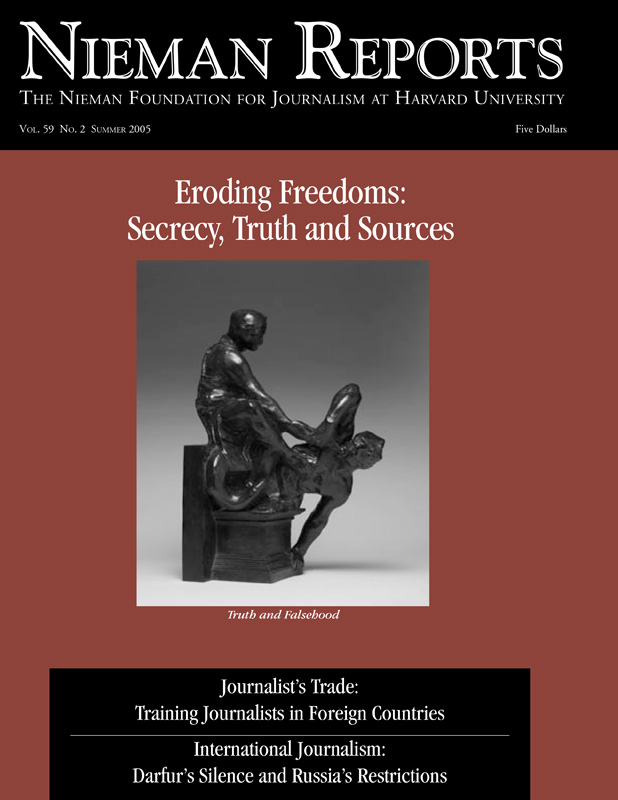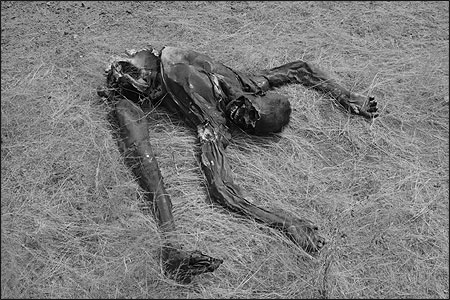
A corpse in Adwa, in Darfur, from December 2004. Photo courtesy Nicholas D. Kristof/The New York Times.
On February 23, 2005, Nicholas Kristof’s New York Times op-ed page column was accompanied by four photographs he’d been given from a secret archive of photos and reports gathered by African Union monitors to document the genocide taking place in Darfur. Usually his words alone appear on this page, but Kristof, who had written many words about what is happening in Darfur, decided the unrelenting death and destruction and the relative lack of news coverage about it made the delivery of this day’s message all the more urgent. In e-mailed responses to questions the editor posed to him, Kristof speaks to the impact his column had and to some broader issues related to journalism.
Melissa Ludtke: Why do you believe the genocide taking place in Darfur has not received—and does not receive—more news coverage?
Nicholas Kristof: Journalism has never done a great job in covering genocide, and in that respect Darfur is typical rather than an unfortunate exception. Look at coverage of the slaughter of Armenians in 1915, of the Holocaust, of Pol Pot’s massacres, of Rwanda—they were all undercovered. One reason is that the slaughter tends to happen in remote and dangerous places, and the authorities deny access. These days, for example, it’s almost impossible for American journalists to get Sudanese travel permits to go to Darfur, and the reality is that by blocking access Sudan has to some extent squelched the story. (That obstructionism makes it all the more impressive that some journalists, like Emily Wax of The Washington Post, have managed to figure out ways to get into Darfur repeatedly, despite dangerous and difficult conditions, and provide first-rate coverage.) The larger problem is that we in the news business are best at covering what presidents announced yesterday; we’re at our weakest in covering ongoing problems that don’t actually happen on any one day but that trickle along in remote parts of the world and that don’t have a constituency of readers.
Ludtke: In publishing several gruesome photographs from Darfur on The New York Times’s op-ed page, you wrote that “it’s time for all of us to look squarely at the victims of our indifference.” You wrote about how you hope that by “inflicting these horrific photos” on readers, you might cut through “our passivity, which allows these people to be slaughtered.” What made you decide that words, by themselves, were no longer adequate to capture the attention you believe this situation deserves?
Kristof: It’s painful for a scribbler like myself to acknowledge, but pictures always grab readers in ways that words usually don’t. As a foreign correspondent, I learned quickly that I was often better off with a story on page five with a photo than with a front-page story that didn’t carry a photo. Particularly with issues like Darfur that have an element of the dutiful in them—horrible things are happening in a country that the reader is never going to visit—the tendency is for the reader to skip over them. No reader is going to bounce over a wrenching photo, though, particularly one in a surprising place like the op-ed page. I don’t believe in using photos idly on the opinion pages, but after 300,000 deaths in Darfur it seemed reasonable to try a new approach, and these photos had real news value.
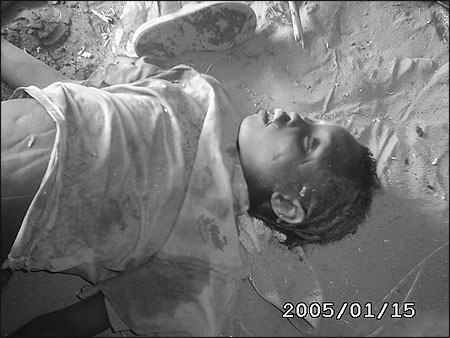
This photo is of a child killed in Hamada in January 2005. Photo courtesy Nicholas D. Kristof/The New York Times.
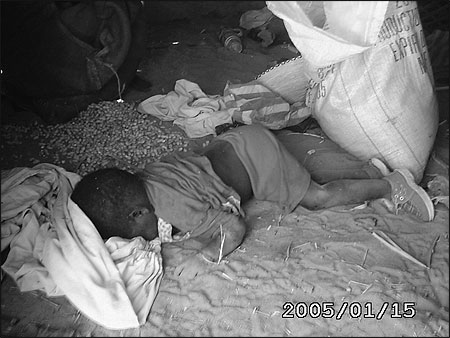
A young boy was one of 107 people who died in an attack by a Sudanese government-backed militia in the village of Hamada. Photo courtesy of Nicholas D. Kristof/The New York Times.
Ludtke: Can you describe the reaction these photographs and your accompanying column received from readers?
Kristof: The reaction was huge, because readers were made to feel uncomfortable about sharing their breakfast coffee with a murdered child. Initially, there was a leak investigation to see who gave me the photos, but that collapsed when it was obvious that the public was less concerned with leaks than with genocide. Several U.S. senators promptly introduced the Darfur Accountability Act, which denounces the genocide and calls for sanctions and a no-fly zone, and they cited the column and blew up the photos to display them on the Senate floor; those may have been the grisliest photos ever on the Senate floor. My favorite tribute came from the Sudanese government, which blamed the sanctions legislation on my columns.
Ludtke: What do you think journalists should have done, or ought to be doing now, given the situation in Darfur?
Kristof: The challenge for journalists in a situation like Darfur is to remember that our job is to cover history, albeit on the fly, and not just events or press conferences. It’s obviously difficult to get the story these days from Darfur, but it’s possible to cover it to some degree from Chad, by crossing illegally from Chad, and by talking to aid workers. And we all know that if the Michael Jackson trial were being held in Darfur, the television networks would figure out ways to get in and provide endless coverage. And the reality is that while there should have been more coverage, the news reports from Darfur did make a real difference. Lots of reporters did figure out ways to get in and get the story out, and the story reached TV and the cover of a news magazine. CNN, the BBC, Emily Wax and Sebastian Mallaby in The Washington Post, my colleagues at the Times—they and many others get credit for pursuing the story in ways that pricked the world’s conscience and resulted in a huge humanitarian effort, a reduced rate of slaughter by the Sudanese government, and increased humanitarian access. There are hundreds of thousands of people alive today who would not otherwise be. So if Darfur underscored our weaknesses in the press, it also is a reminder of the power of our spotlight to do good.
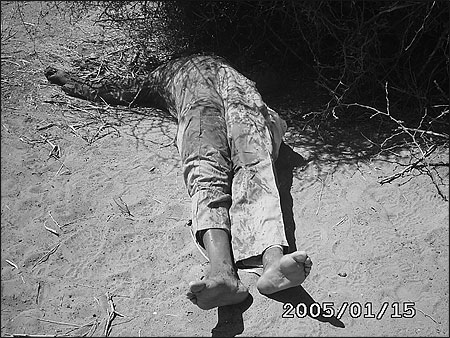
This is a photo of a man who fled barefoot and almost made it to this bush before he was shot dead. Photo courtesy Nicholas D. Kristof/The New York Times.


